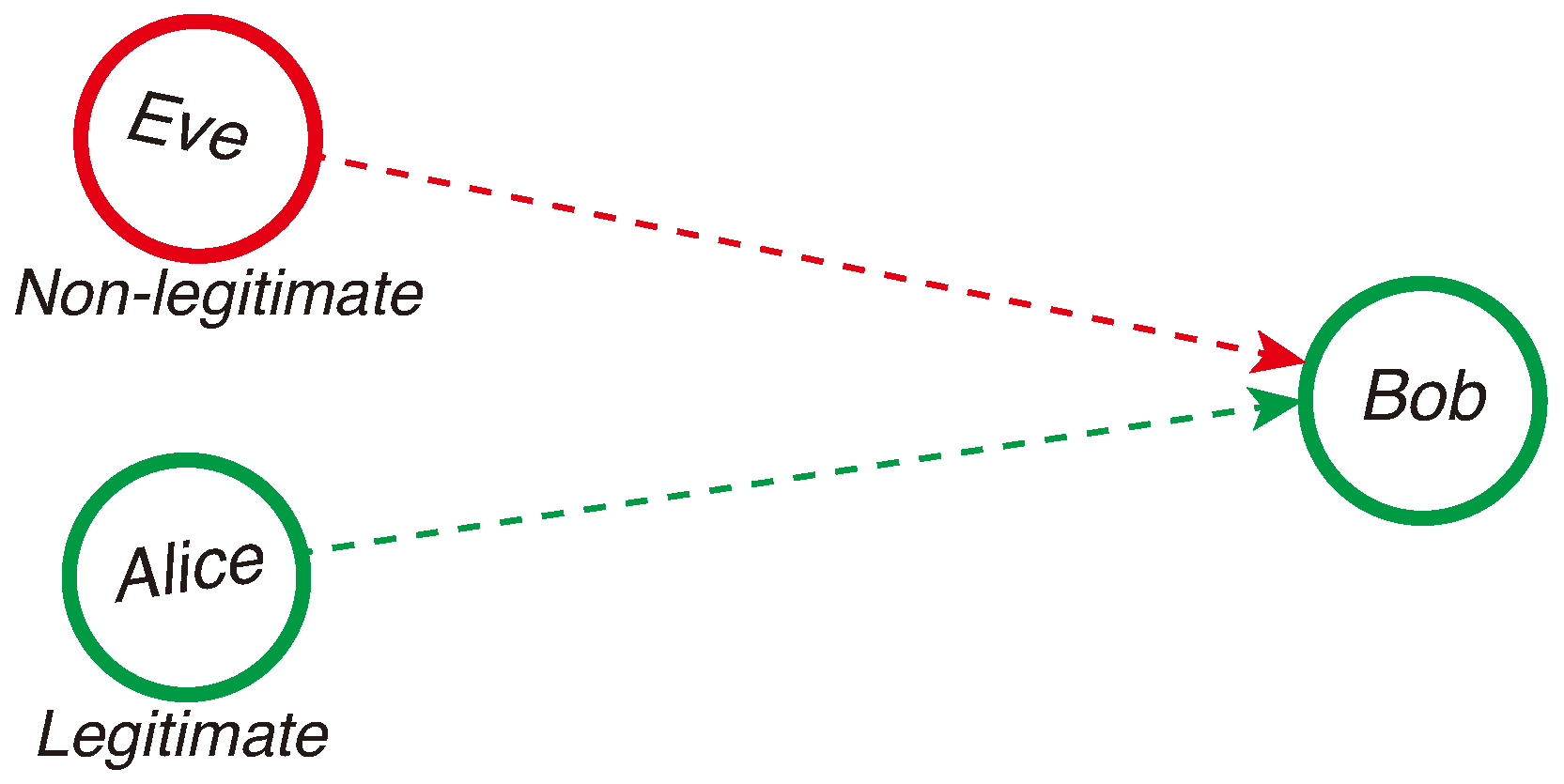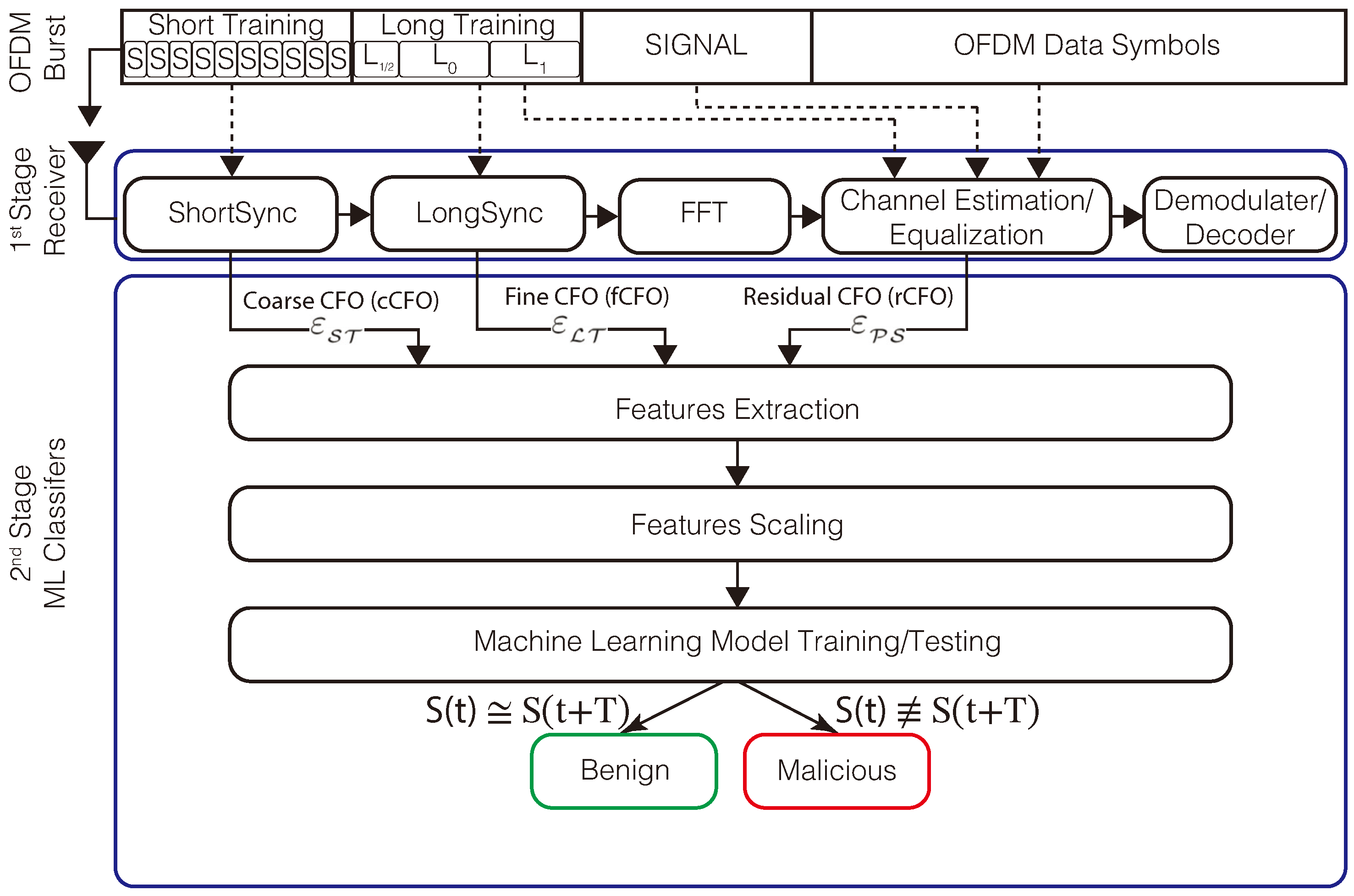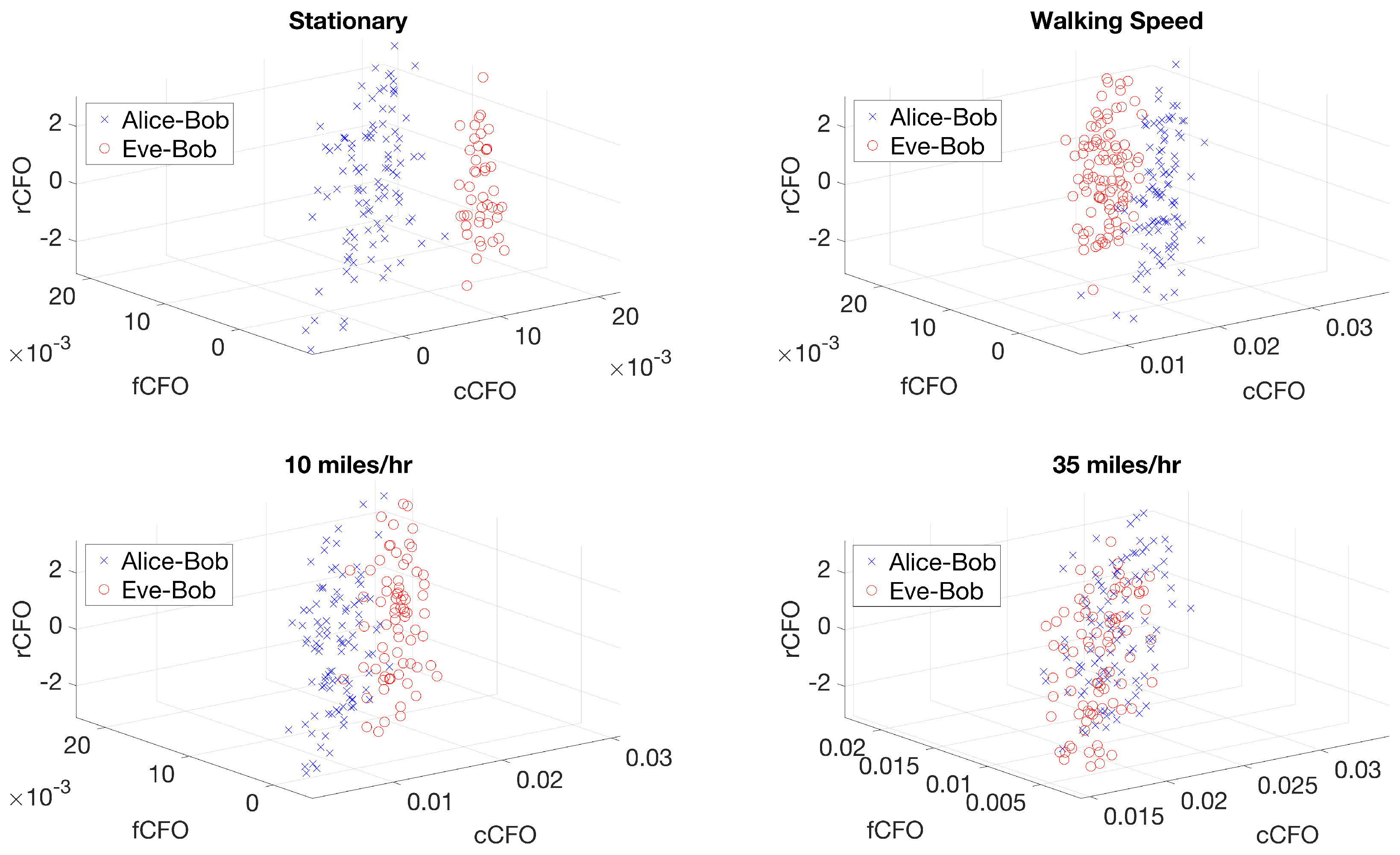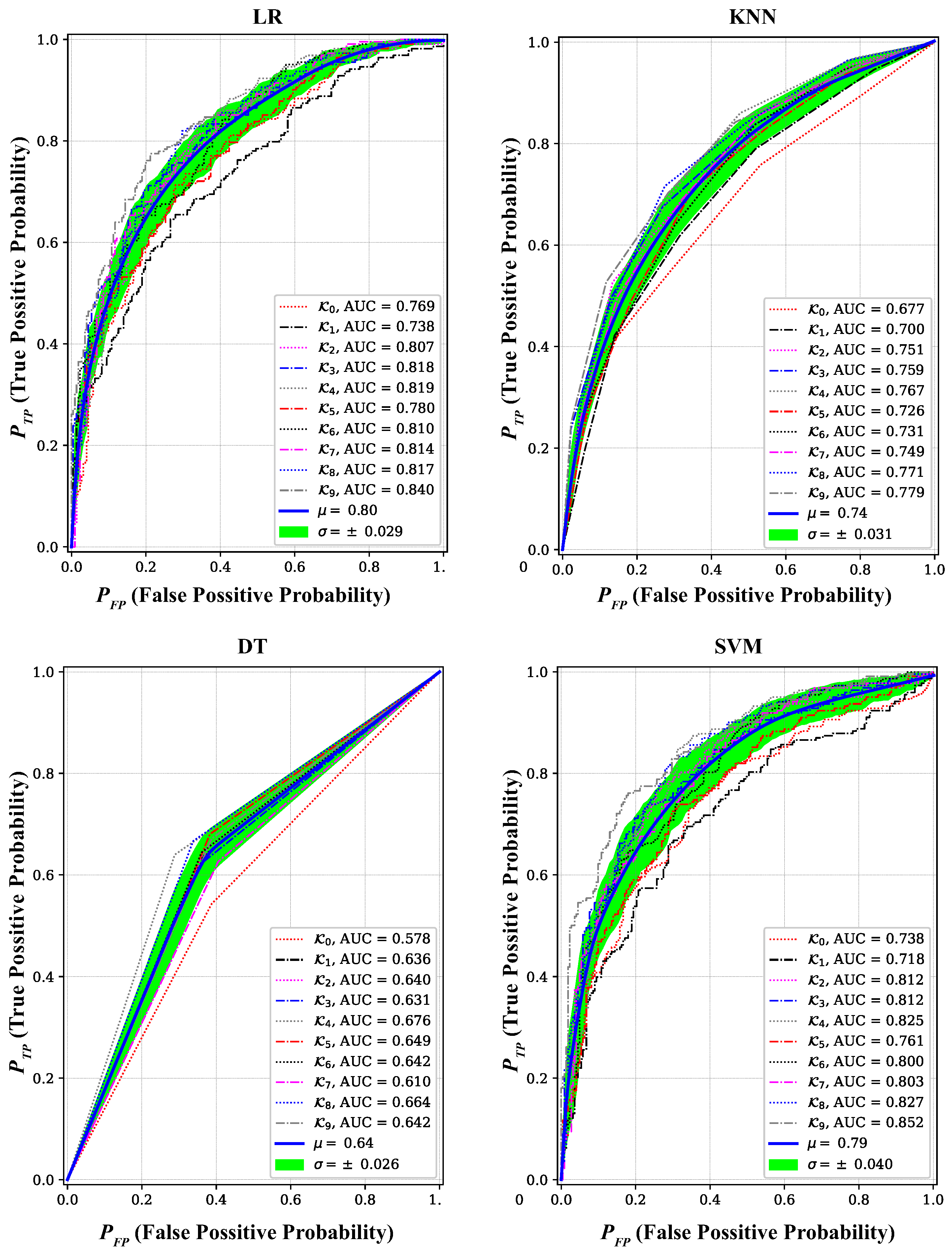Performance Evaluation of Carrier-Frequency Offset as a Radiometric Fingerprint in Time-Varying Channels
Abstract
1. Introduction
- A software-defined radio (SDR) platform is implemented to extract CFO values in a vehicular setup with mobility. A custom implementation is added to the OFDM transceiver to extract CFO values from pilot signals exchanged between the transmitter and receiver. This allows for the investigation of CFO values in realistic scenarios, instead of relying on simulation generated values as in previous studies.
- Higher mobility scenarios are explored to investigate the validity of CFO as a radio-frequency fingerprint for PHY-authentication when the channel is more dynamic.
- Machine learning (ML) classifiers are adopted to be trained and tested on the extracted CFO values for PHY-authentication. Different from conventional approaches that rely on model-based statistical signal processing for classification, which are built with assumptions and designed for inference about the relationships between random variables to estimate one variable from another observation variable, ML approaches are data driven and can adapt to various scenarios with mild assumptions about the environments studied.
2. System Model
3. Experiments and Results
4. Conclusions
Author Contributions
Funding
Institutional Review Board Statement
Informed Consent Statement
Data Availability Statement
Conflicts of Interest
References
- Bloch, M.; Barros, J. Physical-Layer Security: From Information Theory to Security Engineering; Cambridge University Press: Cambridge, UK, 2011. [Google Scholar]
- Albehadili, A.; Al Shamaileh, K.A.; Javaid, A.Y.; Devabhakuni, V.K. Link-Signature-Based Discriminatory Channel Estimation (LS-DCE) for Physical Layer Security in Stationary and Mobile OFDM Transceivers. IEEE Trans. Veh. Technol. 2020, 69, 8119–8131. [Google Scholar] [CrossRef]
- Mathur, S.; Trappe, W.; Mandayam, N.; Ye, C.; Reznik, A. Radio-telepathy: Extracting a secret key from an unauthenticated wireless channel. In MobiCom ‘08: Proceedings of the 14th ACM International Conference on Mobile Computing and Networking; Association for Computing Machinery: New York, NY, USA, 2008; pp. 128–139. [Google Scholar]
- Soltanieh, N.; Norouzi, Y.; Yang, Y.; Karmakar, N.C. A Review of Radio Frequency Fingerprinting Techniques. IEEE J. Radio Freq. Identif. 2020, 4, 222–233. [Google Scholar] [CrossRef]
- Albehadili, A.; Ali, A.; Jahan, F.; Javaid, A.Y.; Oluochy, J.; Devabhaktuniz, V. Machine Learning-based Primary User Emulation Attack Detection in Cognitive Radio Networks using Pattern Described Link-Signature (PDLS). In Proceedings of the 2019 Wireless Telecommunications Symposium (WTS), New York, NY, USA, 9–12 April 2019; pp. 1–7. [Google Scholar] [CrossRef]
- Hou, W.; Wang, X.; Chouinard, J.Y.; Refaey, A. Physical layer authentication for mobile systems with time-varying carrier frequency offsets. IEEE Trans. Commun. 2014, 62, 1658–1667. [Google Scholar] [CrossRef]
- Hua, J.; Sun, H.; Shen, Z.; Qian, Z.; Zhong, S. Accurate and efficient wireless device fingerprinting using channel state information. In Proceedings of the IEEE INFOCOM 2018-IEEE Conference on Computer Communications, Honolulu, HI, USA, 16–19 April 2018; pp. 1700–1708. [Google Scholar]
- Nguyen, N.T.; Zheng, G.; Han, Z.; Zheng, R. Device fingerprinting to enhance wireless security using nonparametric Bayesian method. In Proceedings of the 2011 Proceedings IEEE INFOCOM, Shanghai, China, 10–15 April 2011; pp. 1404–1412. [Google Scholar]
- Vo-Huu, T.D.; Vo-Huu, T.D.; Noubir, G. Fingerprinting Wi-Fi devices using software defined radios. In Proceedings of the 9th ACM Conference on Security & Privacy in Wireless and Mobile Networks, Darmstadt, Germany, 18–20 July 2016; pp. 3–14. [Google Scholar]
- Shen, G.; Zhang, J.; Marshall, A.; Peng, L.; Wang, X. Radio frequency fingerprint identification for LoRa using deep learning. IEEE J. Sel. Areas Commun. 2021, 39, 2604–2616. [Google Scholar] [CrossRef]
- Hou, W.; Wang, X.; Chouinard, J.Y. Physical layer authentication in OFDM systems based on hypothesis testing of CFO estimates. In Proceedings of the 2012 IEEE International Conference on Communications (ICC), Ottawa, ON, Canada, 10–15 June 2012; pp. 3559–3563. [Google Scholar]
- Albehadili, A.; Hussein, O.; Sarkhi, M.; Devabhaktuni, V.K.; Kim, J.; Javaid, A.Y. Machine Learning-based PHY-authentication for Mobile OFDM Transceivers. In Proceedings of the 2020 IEEE 92nd Vehicular Technology Conference (VTC2020-Fall), Virtual Conference, 18 November–16 December 2020; pp. 1–6. [Google Scholar] [CrossRef]
- Simon, E.P.; Ros, L.; Hijazi, H.; Ghogho, M. Joint carrier frequency offset and channel estimation for OFDM systems via the EM algorithm in the presence of very high mobility. IEEE Trans. Signal Process. 2011, 60, 754–765. [Google Scholar] [CrossRef]
- Zhang, R.; Cheng, L.; Wang, S.; Lou, Y.; Gao, Y.; Wu, W.; Ng, D.W.K. Integrated sensing and communication with massive MIMO: A unified tensor approach for channel and target parameter estimation. IEEE Trans. Wirel. Commun. 2024, 23, 8571–8587. [Google Scholar] [CrossRef]
- Qin, Q.; Gui, L.; Cheng, P.; Gong, B. Time-varying channel estimation for millimeter wave multiuser MIMO systems. IEEE Trans. Veh. Technol. 2018, 67, 9435–9448. [Google Scholar] [CrossRef]
- Bloessl, B.; Segata, M.; Sommer, C.; Dressler, F. Performance assessment of IEEE 802.11p with an open source SDR-based prototype. IEEE Trans. Mob. Comput. 2018, 17, 1162–1175. [Google Scholar] [CrossRef]
- Schmidl, T.M.; Cox, D.C. Robust frequency and timing synchronization for OFDM. IEEE Trans. Commun. 1997, 45, 1613–1621. [Google Scholar] [CrossRef]
- Kotsiantis, S.B.; Zaharakis, I.; Pintelas, P. Supervised machine learning: A review of classification techniques. Emerg. Artif. Intell. Appl. Comput. Eng. 2007, 160, 3–24. [Google Scholar]
- Pedregosa, F.; Varoquaux, G.; Gramfort, A.; Michel, V.; Thirion, B.; Grisel, O.; Blondel, M.; Prettenhofer, P.; Weiss, R.; Dubourg, V.; et al. Scikit-learn: Machine learning in Python. J. Mach. Learn. Res. 2011, 12, 2825–2830. [Google Scholar]
- Bishop, C.M.; Nasrabadi, N.M. Pattern Recognition and Machine Learning; Springer: Berlin/Heidelberg, Germany, 2006; Volume 4. [Google Scholar]






| Parameter | Quantity |
|---|---|
| Frequency | 5.86 GHZ |
| Bandwidth | 20 MHz |
| Transmission Mode | Half Duplex |
| RF board A: TX/RX port | Alice’s Antenna |
| RF board A: TX/RX port | Eve’s Antenna |
| HackRF RF board: TX/RX port | Bob’s Antenna |
| Antenna Type | ECOM9-5500 (9 dBi dipole) |
| TX Power | 20 dBm |
| RX Gain | 29 dB (i.e., 92% of maximum gain) |
| Channel Estimator | Least Squares |
| Burst Rate | 2 burst/s |
| Speed | Avg. AUC (Std. Dev.) | LR | KNN | DT | SVM |
|---|---|---|---|---|---|
| 35 mph | () | 0.8 (0.029) | 0.74 (0.031) | 0.64 (0.026) | 0.79 (0.04) |
| 10 mph [12] | 0.97 (0.007) | 0.97(0.012) | 0.91 (0.031) | 0.98(0.006) | |
| Walking [12] | 0.99 (0.004) | 0.99 (0.009) | 0.96 (0.018) | 0.99(0.004) |
| 35 mph | LR (TPR = 0.72, FPR = 0.27) | KNN (TPR = 0.67, FPR = 0.31) | DT (TPR = 0.64, FPR = 0.36) | SVM (TPR = 0.71, FPR = 0.25) | ||||||||
| Alice | Eve | Alice | Eve | Alice | Eve | Alice | Eve | |||||
| Alice | 162 (6) | 60 (5) | Alice | 155 (5) | 67 (5) | Alice | 141 (7) | 81 (7) | Alice | 168 (6) | 54 (6) | |
| Eve | 62 (10) | 160 (10) | Eve | 74 (11) | 148 (11) | Eve | 79 (7) | 143 (6) | Eve | 67 (12) | 155 (12) | |
| 10 mph | LR (TPR = 0.92, FPR = 0.07) | KNN (TPR = 0.92, FPR = 0.07) | DT (TPR = 0.89, FPR = 0.08) | SVM (TPR = 0.93, FPR = 0.06) | ||||||||
| Alice | Eve | Alice | Eve | Alice | Eve | Alice | Eve | |||||
| Alice | 250 (4) | 20 (4) | Alice | 251 (4) | 19 (4) | Alice | 274 (5) | 23 (5) | Alice | 254 (5) | 16 (5) | |
| Eve | 23 (15) | 247 (15) | Eve | 22 (15) | 248 (15) | Eve | 28 (20) | 242 (20) | Eve | 19 (15) | 251 (15) | |
| Walking | LR (TPR = 0.97, FPR = 0.02) | KNN (TPR = 0.96, FPR = 0.03) | DT (TPR = 0.95, FPR = 0.04) | SVM (TPR = 0.97, FPR = 0.02) | ||||||||
| Alice | Eve | Alice | Eve | Alice | Eve | Alice | Eve | |||||
| Alice | 195 (4) | 5 (4) | Alice | 194 (4) | 6 (4) | Alice | 192 (6) | 8 (6) | Alice | 195 (4) | 5 (4) | |
| Eve | 6 (5) | 194 (5) | Eve | 7 (5) | 193 (5) | Eve | 9 (6) | 191 (6) | Eve | 6 (5) | 194 (5) | |
Disclaimer/Publisher’s Note: The statements, opinions and data contained in all publications are solely those of the individual author(s) and contributor(s) and not of MDPI and/or the editor(s). MDPI and/or the editor(s) disclaim responsibility for any injury to people or property resulting from any ideas, methods, instructions or products referred to in the content. |
© 2024 by the authors. Licensee MDPI, Basel, Switzerland. This article is an open access article distributed under the terms and conditions of the Creative Commons Attribution (CC BY) license (https://creativecommons.org/licenses/by/4.0/).
Share and Cite
Albehadili, A.; Javaid, A.Y. Performance Evaluation of Carrier-Frequency Offset as a Radiometric Fingerprint in Time-Varying Channels. Sensors 2024, 24, 5670. https://doi.org/10.3390/s24175670
Albehadili A, Javaid AY. Performance Evaluation of Carrier-Frequency Offset as a Radiometric Fingerprint in Time-Varying Channels. Sensors. 2024; 24(17):5670. https://doi.org/10.3390/s24175670
Chicago/Turabian StyleAlbehadili, Abdulsahib, and Ahmad Y. Javaid. 2024. "Performance Evaluation of Carrier-Frequency Offset as a Radiometric Fingerprint in Time-Varying Channels" Sensors 24, no. 17: 5670. https://doi.org/10.3390/s24175670
APA StyleAlbehadili, A., & Javaid, A. Y. (2024). Performance Evaluation of Carrier-Frequency Offset as a Radiometric Fingerprint in Time-Varying Channels. Sensors, 24(17), 5670. https://doi.org/10.3390/s24175670







